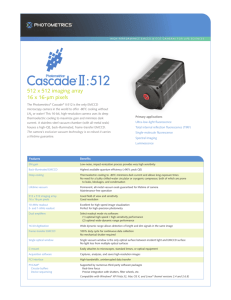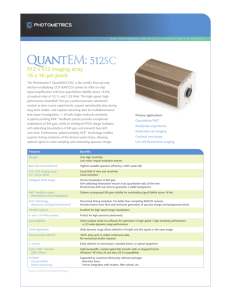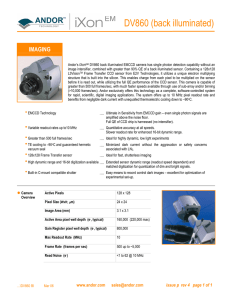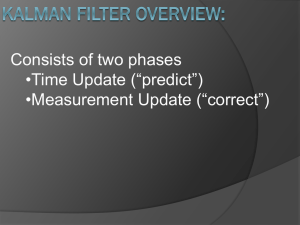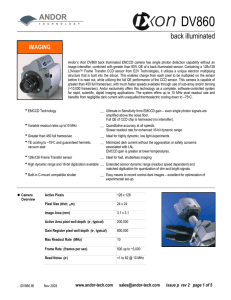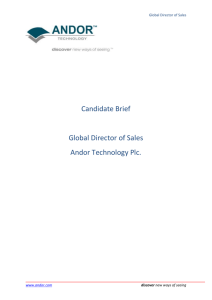iXon3 897 EMCCD - Andor Technology
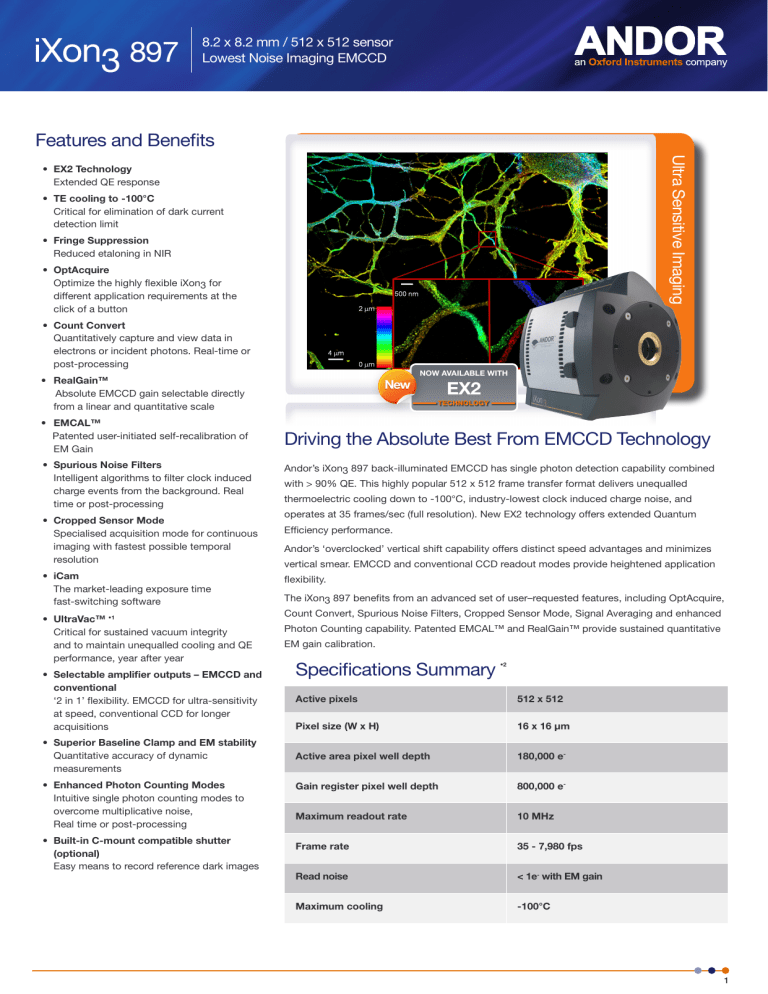
iXon3 897 8.2 x 8.2 mm / 512 x 512 sensor
Lowest Noise Imaging EMCCD
Features and Benefits
• EX2 Technology
Extended QE response
• TE cooling to -100°C
Critical for elimination of dark current
detection limit
• Fringe Suppression
Reduced etaloning in NIR
• OptAcquire
Optimize the highly flexible iXon3 for
different application requirements at the
click of a button
• Count Convert
Quantitatively capture and view data in
electrons or incident photons. Real-time or
post-processing
• RealGain™
Absolute EMCCD gain selectable directly
from a linear and quantitative scale
• EMCAL™
Patented user-initiated self-recalibration of
EM Gain
• Spurious Noise Filters
Intelligent algorithms to filter clock induced
charge events from the background. Real
time or post-processing
• Cropped Sensor Mode
Specialised acquisition mode for continuous
imaging with fastest possible temporal
resolution
• iCam
The market-leading exposure time
fast-switching software
• UltraVac™ •1
Critical for sustained vacuum integrity
and to maintain unequalled cooling and QE
performance, year after year
• Selectable amplifier outputs – EMCCD and
conventional
‘2 in 1’ flexibility. EMCCD for ultra-sensitivity
at speed, conventional CCD for longer
acquisitions
• Superior Baseline Clamp and EM stability
Quantitative accuracy of dynamic
measurements
• Enhanced Photon Counting Modes
Intuitive single photon counting modes to
overcome multiplicative noise,
Real time or post-processing
• Built-in C-mount compatible shutter
(optional)
Easy means to record reference dark images
NOW AVAILABLE WITH
EX2
TECHNOLOGY
Driving the Absolute Best From EMCCD Technology
Andor’s iXon3 897 back-illuminated EMCCD has single photon detection capability combined with > 90% QE. This highly popular 512 x 512 frame transfer format delivers unequalled thermoelectric cooling down to -100°C, industry-lowest clock induced charge noise, and operates at 35 frames/sec (full resolution). New EX2 technology offers extended Quantum
Efficiency performance.
Andor’s ‘overclocked’ vertical shift capability offers distinct speed advantages and minimizes vertical smear. EMCCD and conventional CCD readout modes provide heightened application flexibility.
The iXon3 897 benefits from an advanced set of user–requested features, including OptAcquire,
Count Convert, Spurious Noise Filters, Cropped Sensor Mode, Signal Averaging and enhanced
Photon Counting capability. Patented EMCAL™ and RealGain™ provide sustained quantitative
EM gain calibration.
Specifications Summary
•2
Active pixels 512 x 512
Pixel size (W x H)
Active area pixel well depth
Gain register pixel well depth
Maximum readout rate
Frame rate
Read noise
16 x 16 μm
180,000 e -
800,000 e -
10 MHz
35 - 7,980 fps
< 1e with EM gain
Maximum cooling -100°C
1
iXon3 897 8.2 x 8.2 mm / 512 x 512 sensor
Lowest Noise Imaging EMCCD
System Specifications
•2
Model number
Sensor options
Active pixels
Pixel size
Image area
Minimum temperature, air cooled, ambient 20°C
Recirculator liquid cooling, coolant @ 22°C, >0.75l/min
Chiller liquid cooling, coolant @ 10°C, >0.75l/min
Digitization
Triggering
System window type
897
#BV : Back Illuminated, standard AR coated
BVF : Back Illuminated, standard AR coated with fringe suppression
UVB : Back Illuminated, standard AR with additional lumogen coating
#EX: Back illuminated, dual AR coated
EXF: Back illuminated, dual AR coated with fringe suppression
512 x 512
16 x 16 μm
8.2 x 8.2 mm with 100% fill factor
-85ºC
-95ºC
-100ºC
True 14 bit @ 10, 5, 3 & 1 MHz readout rate (optional 16-bit available @ 1 MHz)
Internal, External, External Start, External Exposure, Software Trigger
#BV and BVF sensors: UV-grade fused silica, ‘Broadband VIS-NIR’, wedged
UVB sensor: UV-grade fused silica, ‘Broadband VUV-NIR’, unwedged
#EX, EXF sensors: UV-grade fused silica, ‘Broadband VUV-NIR’, wedged
Blemish specification Grade 1 sensor (CCD97), as defined by the sensor manufacturer e2v (see www.e2v.com
for further details)
Advanced Performance Specifications
•2
Dark current and background events •3, 4
0.001
0.005
Dark current (e /pixel/sec) @ -85°C
Spurious background (events/pix) @ 1000x gain / -85°C
Active area pixel well depth
Gain register pixel well depth •5
Pixel readout rates
180,000 e -
800,000 e -
Read noise (e ) •6
10 MHz through EMCCD amplifier
5 MHz through EMCCD amplifier
3 MHz through EMCCD amplifier
1 MHz through EMCCD amplifier
1 MHz through conventional amplifier
Linear absolute Electron Multiplier gain
Linearity •7
Vertical clock speed
Electron Multiplying Amplifier
10, 5, 3, 1 MHz
Without Electron Multiplication
49
42
32
21
6
Better than 99%
0.3 to 3.3 µs (variable)
Conventional Amplifier
3 & 1 MHz
With Electron Multiplication
< 1
< 1
< 1
< 1
-
1 - 1000 times via RealGain™ (calibration stable at all cooling temperatures)
Frame Rates (Standard Mode)
•8
Binning
1 x 1
512 x 512
35
256 x 256
68
128 x 128
132
2 x 2
4 x 4
68
131
132
246
248
439
8 x 8 231 426 699
Frame Rates (Cropped Sensor Mode)
•8
Array size
64 x 64
251
452
735
1031
512 x 100
168
313
549
833
512 x 32
456
757
1111
1351
512 x 1
2128
-
-
-
Binning
1 x 1
2 x 2
4 x 4
8 x 8
256 x 256
69
136
260
483
128 x 128
395
743
1327
2184
64 x 64
988
1764
2902
4285
Array size
32 x 32
2577
5400
6068
7375
512 x 100
176
342
649
1268
512 x 32
538
1025
1877
3209
512 x 1
7980
-
-
-
2
iXon3 897 8.2 x 8.2 mm / 512 x 512 sensor
Lowest Noise Imaging EMCCD
Quantum Efficiency Curves
•9
QE vs. Fluorophores Curve
100
90
80
70
60
50
BV, BVF
EX, EXF
40
30
UVB
20
10
0
200 300 400 500 600 700 800
Wavelength (nm)
900 1000 1100 1200
Stability Plot Application Image
EM Gain stability in the iXon3 897. 200 frame kinetic series; frame transfer
(overlapped) acquisition; 30 ms exposure time; x300 EM gain.
Composite triple color image of a microtubule protein (EB1-GFP) imaged with objective-type TIRFM (60x 1.45NA), using the 897 model. The different colors reveal the dynamics of the microtubules over time: frame 1 = red; frame 10 = green; frame 20 = blue.
Courtesy of Dr Derek Toomre, CINEMA laboratory, Dept. Cell Biology, Yale University.
3
iXon3 897 8.2 x 8.2 mm / 512 x 512 sensor
Lowest Noise Imaging EMCCD
Creating The Optimum
Product for You
How to customise the iXon3 897:
Step 1.
Simply select from the 2 digitisation options that best suit your needs from the selection opposite.
Step 2.
Please indicate if you require a shutter fitted to your iXon3 897.
Step 3.
The iXon3 897 comes with 5 options for sensor types. Please select the sensor which best suits your needs.
Step 4.
Please indicate alternative window option if required.
Step 5.
Please indicate which software and controller card you require.
Step 6.
For compatibility, please indicate which accessories are required.
Step 6.
The following accessories are available:
OPTOMASK Optomask microscopy accessory, used to mask unwanted sensor area during Cropped Sensor mode acquisition.
XW-RECR Re-circulator for enhanced cooling performance
ACC-XW-CHIL-160 Oasis 160 Ultra compact chiller unit
OA-CNAF C-mount to Nikon F-mount adapter
OA-COFM C-mount to Olympus adapter
OA-CTOT C-mount to T-mount adapter
DU-897
D example shown
C
S
Step 1.
Choose digitisation option
D: 10, 5, 3 & 1 MHz readout @ 14 bit
E: 10, 5, & 3 MHz readout @ 14 bit and
1 MHz @ 16 bit
0 -
EXF
Step 2.
Choose shutter option
Step 3.
Choose sensor finish option
#BV : Back-illuminated, standard AR coated
BVF : Back-illuminated, standard AR coated with
fringe suppression
UVB : Back Illuminated, standard AR with
additional lumogen coating
#EX : Back-illuminated, EX2 dual AR coated
EXF : Back-illuminated, EX2 dual AR coated with
fringe suppression
0: No shutter
Step 4.
Select alternative camera window (optional)
The standard window has been selected to satisfy most applications. However, other options are available. The alternative camera window code must be specified at time of ordering.
To view and select other window options please refer to the ‘ Camera Windows
Supplementary Specification Sheet ’ which gives the transmission characteristics, product codes and procedure for entering the order. Further detailed information on the windows can be found in the Technical note – ‘ Camera Windows: Optimizing for Different Spectral
Regions ’.
Step 5.
The iXon3 897 requires a controller card and one of the following software options:
CCI-24 PCIe Controller card.
Note: The CCI-24 PCIe controller card is not compatible with PCs with Intel C612 chipsets.
Solis Imaging A 32-bit and fully 64-bit enabled application for Windows (XP, Vista, 7 and 8) offering rich functionality for data acquisition and processing. AndorBasic provides macro language control of data acquisition, processing, display and export.
Andor SDK A software development kit that allows you to control the Andor range of cameras from your own application. Available as 32 and 64-bit libraries for Windows (XP, Vista, 7 and 8), compatible with C/C++, C#, Delphi, VB6, VB.NET, LabVIEW and Matlab. Linux SDK compatible with C/C++.
Andor iQ A comprehensive multi-dimensional imaging software package. Offers tight synchronization of EMCCD with a comprehensive range of microscopy hardware, along with comprehensive rendering and analysis functionality. Modular architecture for best price/ performance package on the market.
Third party software compatibility
Drivers are available so that the iXon3 range can be operated through a large variety of third party imaging packages. See Andor web site for detail: andor.com/software/
4
iXon3 897 8.2 x 8.2 mm / 512 x 512 sensor
Lowest Noise Imaging EMCCD
Product Drawings
Dimensions in mm [inches]
46.5 [1.83]
137.8 [5.42]
120.0 [4.72]
76.2 [3.0]
Mounting points, 6 off 1/4-20 UNC
Tapped x 15mm deep
40 [1.57]
147 [5.78]
Third-angle projection n
Focal Plane
17.5 [0.69] from face plate
4 off M5 x 5mm deep
46.5
[1.83]
17.5 [0.69]
42.0 [1.65]
DIRECTION FOR
CABLE
60° n
= position of pixel 1,1
Weight: 3.4 kg [7 lb 8 oz]
Fire SMB
Shutter SMB Arm SMB
External Trigger SMB
Cooler power
MDR 36 interface connector,
42 x 42 x 12, cable is attached at 60°
I²C
SolidWorks Detached drawing - Out-of-Sync Print
Water connectors for 6 mm I.D. tubing
Connector panel
Connecting to the iXon3
Typical Applications
Single Molecule Detection
Camera Control
TTL / Logic
Super Resolution (PALM, STORM)
Connector type: PCI or PCIe
TIRF Microscopy
SolidWorks Detached drawing - Out-of-Sync Print
Connector type: SMB, provided with SMB - BNC cable
Fire (Output), Shutter (Output), Arm (Output), External Trigger (Input)
Selective/Single Plane Illumination Microscopy (SPIM)
Calcium Flux
I 2 C connector
Compatible with Fischer SC102A053-130, pinouts as follow:
1 = I 2 C Clock, 2 = I 2 C Data, 3 = Ground , 4 = +5 Vdc
Whole Genome Sequencing
FRET / FRAP
Microspectroscopy / Hyperspectral Imaging
Minimum cable clearance required at rear of camera
90 mm
Lucky Astronomy
Single Photon Counting
5
iXon3 897 8.2 x 8.2 mm / 512 x 512 sensor
Lowest Noise Imaging EMCCD
Order Today
Need more information? At Andor we are committed to finding the correct solution for you. With a dedicated team of technical advisors, we are able to offer you one-to-one guidance and technical support on all Andor products. For a full listing of our local sales offices, please see: andor.com/contact
Our regional headquarters are:
Europe Japan
Belfast, Northern Ireland
Phone +44 (28) 9023 7126
Fax +44 (28) 9031 0792
Tokyo
Phone +81 (3) 3518 6488
Fax +81 (3) 3518 6489
North America China
Phone +1 (860) 290 9211
Fax +1 (860) 290 9566
Phone +86 (10) 5129 4977
Fax +86 (10) 6445 5401
Items shipped with your camera:
1x PCI or PCIe controller card + SATA adapter*
1x Controller card splitter/fly-lead (if required)
1x 3m iXon3 detector cable
2x 2m SMB - BNC connection cables
1x Power supply with mains cable
1x Quick launch guide
1x CD containing Andor user manuals
1x Individual system performance booklet
1x Disposable ESD wrist strap
Front cover image: A large scale 3D STORM image of a cultured hippocampal neuron colored in z. Courtesy of Melike Lakadamyali, Institute of Photonic Sciences,
ICFO, Barcelona, Spain and Hazen Babcock from
Harvard University, Cambridge, MA
Footnotes:
Specifications are subject to change without notice
1. Assembled in a state-of-the-art cleanroom facility, Andor’s UltraVac™ vacuum process combines a permanent hermetic vacuum seal (no o-rings), with a stringent protocol to minimize outgassing, including use of proprietary materials.
2. Figures are typical unless otherwise stated.
3. The dark current measurement is averaged over the sensor area excluding any regions of blemishes.
4. Using Electron Multiplication the iXon3 is capable of detecting single photons, therefore the true camera detection limit is set by the number of ‘dark’ background events. These events consist of both residual thermally generated electrons and Clock Induced Charge (CIC) electrons (also referred to as Spurious Noise), each appearing as random single spikes above the read noise floor.
A thresholding scheme is employed to count these single electron events and is quoted as a probability of an event per pixel. Acquisition conditions are full resolution and max frame rate (10 MHz readout; frame-transfer mode; 0.5 µs vertical clock speed; x 1000 EM gain; 10 ms exposure; -85°C).
5. The EM register on CCD97 sensors has a linear response up to ~400,000 electrons and a full well depth of
~800,000 electrons.
6. Readout noise is for the entire system. It is a combination of sensor readout noise and A/D noise.
Measurement is for Single Pixel readout with the sensor at a temperature of -75°C and minimum exposure time under dark conditions. Under Electron Multiplying conditions, the effective system readout noise is reduced to sub 1e levels.
7. Linearity is measured from a plot of counts vs exposure time under constant photon flux up to the saturation point of the system.
8. All measurements are made with 0.3 µs vertical clock speed. It also assumes internal trigger mode of operation.
9. Quantum efficiency of the sensor at 25°C, as supplied by the sensor manufacturer.
Recommended Computer Requirements:
• 3.0 GHz single core or 2.6 GHz multi core processor
• 2 GB RAM
• 100 MB free hard disc to install software (at least
1 GB recommended for data spooling)
• PCI 2.2 or PCIe slot*
• 10,000 rpm SATA hard drive preferred for extended
kinetic series
• Windows (XP, Vista, 7 and 8) or Linux
* Note: The CCI-24 PCIe controller card is not
compatible with PCs with Intel C612 chipsets.
Operating & Storage Conditions
• Operating Temperature: 0°C to 30°C ambient
• Relative Humidity: < 70% (non-condensing)
• Storage Temperature: -25°C to 50°C
Power Requirements
• 100 - 240 VAC, 50/60 Hz
FM40523 EMS91062
LiXon3897SS 0315 R1
6
